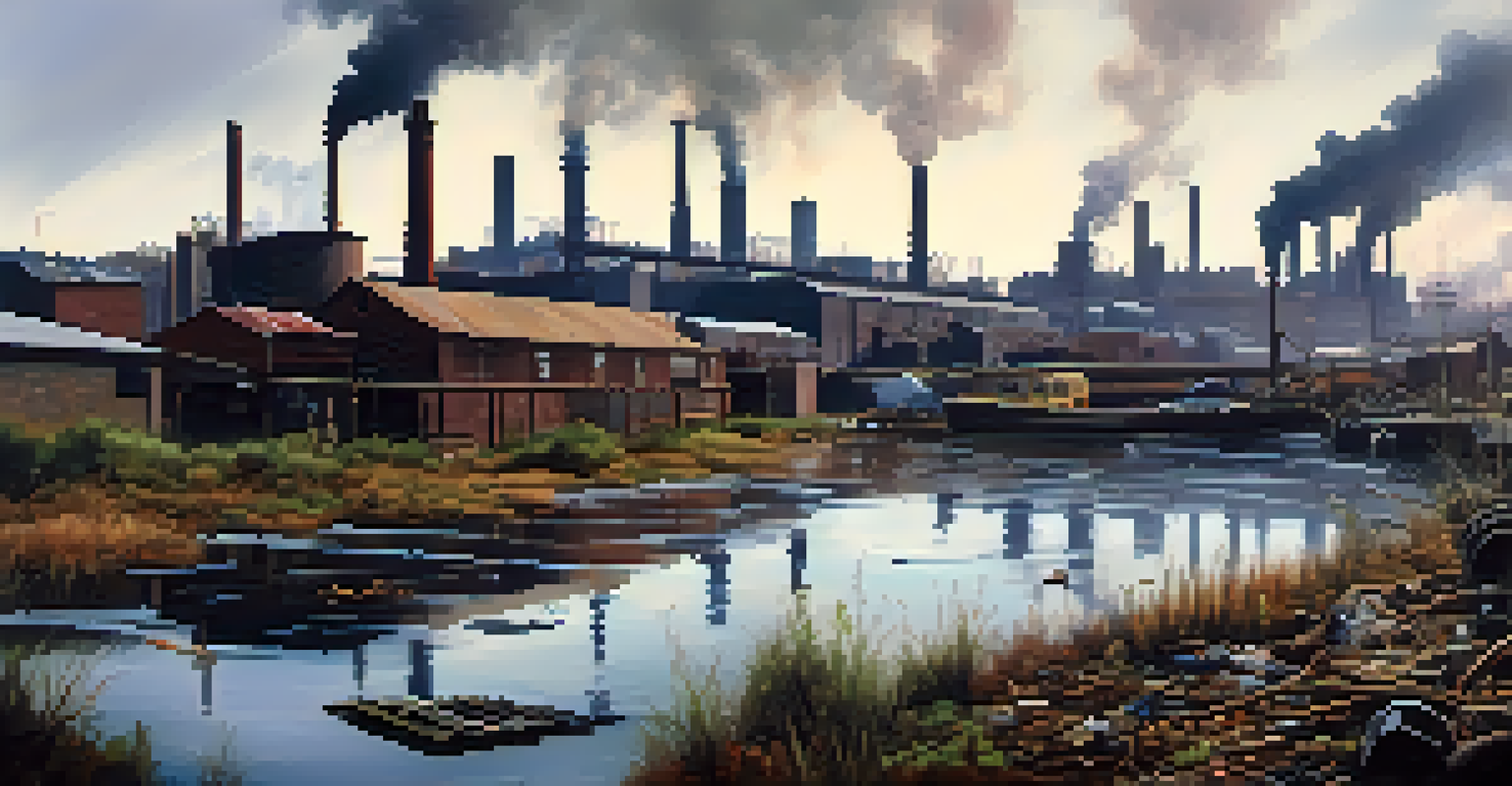Water Usage in Fashion: A Hidden Environmental Crisis

The Fashion Industry's Thirst for Water
The fashion industry is one of the largest consumers of water, often overshadowing its environmental impact. From cotton cultivation to the dyeing process, water is essential at every step of clothing production. In fact, it’s estimated that producing a single cotton t-shirt requires around 2,700 liters of water—enough for one person to drink for two and a half years!
Fashion is the armor to survive the reality of everyday life.
This immense water usage not only depletes local water resources but also contributes to water scarcity in many regions. Countries like India and China, where much of the world's apparel is produced, often face severe water shortages, exacerbated by the demands of fast fashion. The irony is stark: while the industry thrives, local communities struggle to access clean water.
As consumers, we often overlook this hidden crisis, focusing instead on the price tags and trends. However, understanding the water footprint of our clothing can lead to more mindful purchasing decisions. By becoming aware of the underlying issues, we can advocate for more sustainable practices within the fashion industry.
Water Pollution: The Dark Side of Fashion Production
While the sheer volume of water used in fashion is alarming, the pollution of water resources is equally troubling. Many manufacturers dispose of toxic dyes and chemicals directly into rivers and streams, contaminating local water supplies. This not only affects aquatic life but also poses serious health risks to nearby communities that rely on these water sources.

For instance, in Bangladesh, the river Buriganga has become so polluted by the garment industry that it is no longer safe for drinking or bathing. The toxic runoff can cause skin diseases, reproductive issues, and other severe health problems. This pollution cycle highlights a critical aspect of the fashion industry that often goes unnoticed by consumers.
Fashion's Water Usage Crisis
The fashion industry consumes vast amounts of water, with the production of a single cotton t-shirt requiring around 2,700 liters.
Addressing water pollution requires a collective effort from brands, governments, and consumers. By supporting companies that prioritize sustainable practices and advocating for stricter regulations, we can help mitigate this environmental crisis. It's not just about looking good; it's about ensuring that our choices do not come at the expense of the planet and its people.
The Role of Cotton: A Water-Intensive Crop
Cotton is often dubbed 'the fabric of our lives,' but its cultivation is incredibly water-intensive. It accounts for nearly 30% of the world's fiber production, yet it requires vast amounts of water for irrigation. In regions where water is already scarce, this poses significant challenges for both farmers and local ecosystems.
We don’t need to be better than the rest; we need to be better than we were yesterday.
Moreover, conventional cotton farming relies heavily on pesticides and fertilizers, which can further harm water quality. The runoff from these chemicals can seep into waterways, creating a cycle of pollution that extends far beyond the fields. This situation raises important questions about the true cost of our clothing choices.
Sustainable alternatives, such as organic cotton or hemp, offer promising solutions to this crisis. These crops generally require less water and fewer chemicals, making them more environmentally friendly. As consumers, opting for these alternatives can drive demand for sustainable practices and help reduce the overall water footprint of the fashion industry.
Fast Fashion's Contribution to Water Waste
Fast fashion has revolutionized the way we shop, but it has also exacerbated water waste in the industry. With the constant churn of new collections, the demand for cheap, rapidly produced garments leads to a significant increase in water consumption. The result? A staggering amount of water is wasted in the name of fleeting trends.
For example, brands often produce items in bulk, leading to overproduction and excessive waste. Unsold garments frequently end up in landfills, where they contribute to environmental degradation. This cycle of consumption not only harms the planet but also perpetuates a culture of disposability among consumers.
Pollution from Fashion Production
Many manufacturers discharge toxic dyes into water sources, jeopardizing local communities' health and aquatic ecosystems.
By shifting our mindset away from fast fashion and towards sustainable choices, we can help curb this crisis. Supporting brands that prioritize ethical practices and investing in timeless pieces instead of trendy items can make a difference. Together, we can challenge the status quo and advocate for a more sustainable fashion industry.
Innovative Solutions: Water-Saving Technologies
Fortunately, the fashion industry is beginning to embrace innovative solutions to tackle its water crisis. Technologies such as waterless dyeing and closed-loop systems are gaining traction, allowing brands to significantly reduce their water footprint. These advancements not only minimize waste but also demonstrate the industry's potential for positive change.
For instance, some companies are utilizing digital printing techniques that require minimal water compared to traditional methods. Others are implementing rainwater harvesting systems and recycling wastewater in their production processes. These innovations show that it is possible to create beautiful clothing while being mindful of water usage.
As consumers, we can support these forward-thinking brands and advocate for wider adoption of water-saving technologies. By choosing to invest in companies that prioritize sustainability, we can help drive change in the industry. Every purchase we make can be a vote for a more responsible and environmentally friendly fashion sector.
The Importance of Consumer Awareness and Responsibility
One of the most effective ways to combat the water crisis in fashion is through consumer awareness and responsibility. By educating ourselves about the environmental impacts of our clothing choices, we can make informed decisions that prioritize sustainability. This awareness can lead to a ripple effect, influencing others to consider the broader implications of their purchases.
Simple actions, like researching brands before shopping or opting for second-hand clothing, can significantly reduce our water footprint. Additionally, sharing information with friends and family can amplify our impact, creating a community of conscious consumers. When we demand transparency and sustainability from brands, we encourage them to adopt better practices.
Need for Sustainable Practices
Shifting towards sustainable alternatives and advocating for responsible policies can significantly reduce the fashion industry's water footprint.
Ultimately, being a responsible consumer means recognizing the interconnectedness of our choices and their environmental consequences. By fostering a culture of awareness, we can help shift the fashion industry towards a more sustainable future. Together, we can make a difference, one garment at a time.
Advocating for Policy Changes in the Fashion Industry
While individual choices matter, systemic change is essential to address the water crisis in fashion. Advocating for policy changes at local, national, and international levels can create a lasting impact on the industry. By pushing for regulations that promote sustainable practices, we can hold brands accountable for their water usage and pollution.
Support for initiatives that encourage responsible water management and treatment in manufacturing processes can lead to significant improvements. For example, stricter regulations on wastewater disposal can help protect local water sources from contamination. Additionally, incentivizing sustainable practices through subsidies or grants can encourage brands to invest in eco-friendly technologies.

As consumers, we have the power to influence policy changes by voicing our concerns and supporting organizations that advocate for environmental sustainability. By standing together, we can create a movement that prioritizes the health of our planet over profit. Together, we can work towards a fashion industry that respects our most precious resource: water.